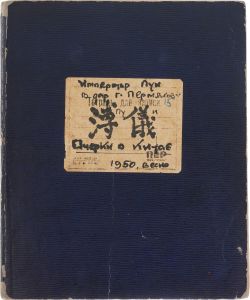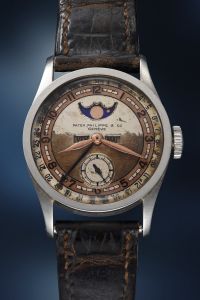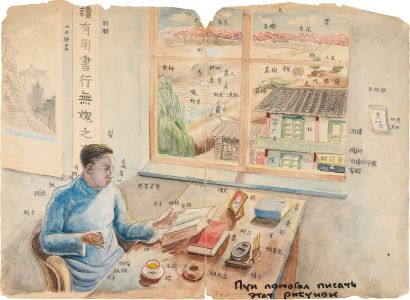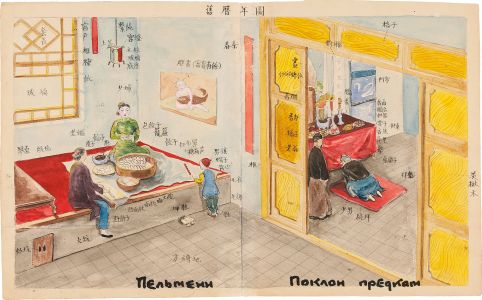
“Back in the Manchukuo period, Puyi wore this exceptional watch day to day. I was particularly fond of it, not only because of its superb quality, but also the fact that it was such a personal item of Puyi!”
—Aisin-Gioro Yuyan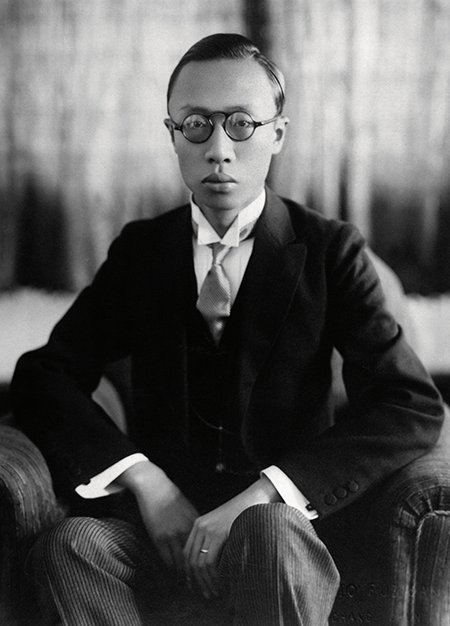
©Getty Images: Ullstein bild
A Parting Gift: The WatchFrom the day it was sold in 1937, Puyi’s Patek Philippe Ref. 96 Quantieme Lune wristwatch was of immense value. It is one of only eight such timepieces known (five of them platinum, two gold). Phillips researchers have traced the watch to a sale in Guillermin, a Parisian luxury store then located on Place Vendome, home of some of the world’s leading jewellers.
The documentation is clear that Puyi brought this watch to a Khabarovsk prison camp known as Special Object No. 45 and gave it to Permyakov. This was where the deposed emperor and his entourage were held, along with Japanese officers and Manchurian ministers captured by the Soviet Red Army in 1945. Puyi, as well as the other ranking officials, was accused of being a war criminal.
In his memoir, Yuyan, Puyi’s nephew, states:
‘I was loyal to Puyi during our time in the Soviet prisons, so he rewarded me with a calendar embedded platinum watch which I was, undoubtedly, very familiar with. Back in the Manchukuo
period, Puyi wore this exceptional watch day to day. I was particularly fond of it, not only because
of its superb quality, but also the fact that it was such a personal item of Puyi! ’
On 31 July 1950, two senior officials approached the former emperor’s cell. As Yuyan recalled, Permyakov interpreted, ‘The Soviet government has decided to let you return to China. You must swiftly pack your belongings and get set now. Hurry up!’
Puyi turned to Yuyan.
‘Do you still have the calendar-embedded platinum watch with you?’ he whispered.
‘Yes, I am wearing it,’ Yuyan answered.
‘Please take it off,’ Puyi said.Without hesitation, Yuyan removed and returned his cherished platinum watch to Puyi, who passed it to Permyakov.
The Russian slipped the watch into his pocket. Upon his death, he bequeathed the watch to his heirs.
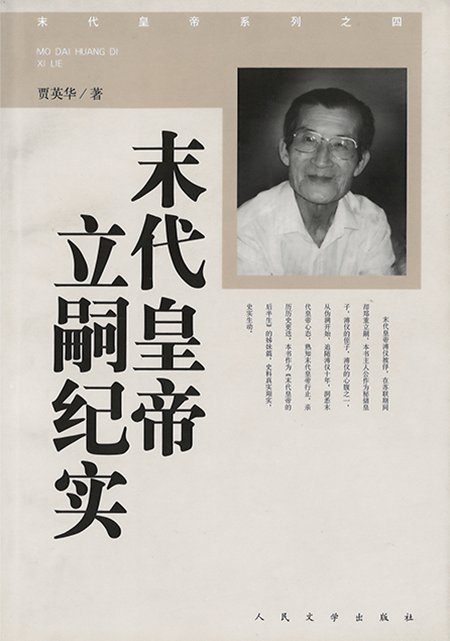
Aisin-Gioro Yuyan: A Written Record of Heir Appointment by the Last Emperor by Jia Yinghua. The Imperial Patek Philippe
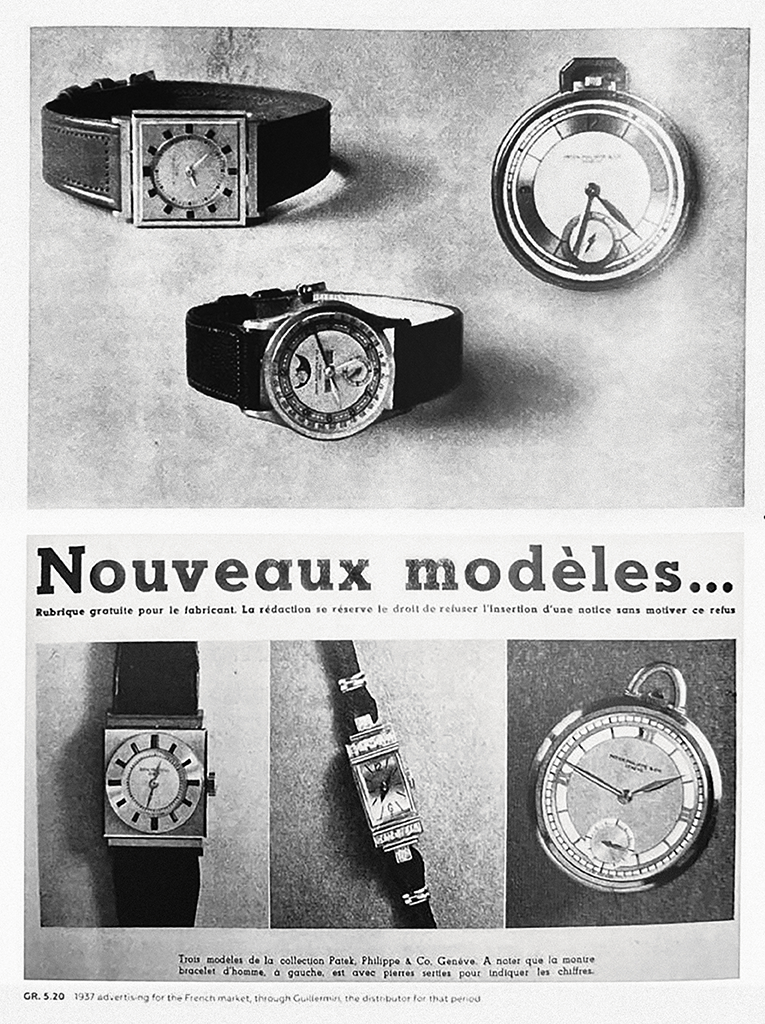
Guillermin advertisement for the Patek Philippe Ref. 96QL in 1937. This legendary Patek Philippe Ref. 96QL with triple date and moon phase is one of the most crucial examples ever to appear in the market. With its pure lines, this timepiece is recognized as the essence of the round wristwatch and one of the finest symbols of Patek Philippe, the Calatrava. Supremely elegant yet simply cased in platinum, its silhouette and large unsigned crown express the aesthetics of Bauhaus and understated functionality. The timepiece measures at 30mm in diameter features the crucial identity of a Ref. 96 – slim, round case, clean flat bezel and tapered lugs. The snap case is extremely well-preserved with its original factory finishes, and it retains its satin polishing. The curved lugs are thick and well-proportioned. The case-maker can be found on the inner caseback, stamped just below its case numbers. The Poinçon de Maître No.4 (known as the ‘Key of Geneva’) was first registered on September 8th, 1934. It is specific to Antoine Gerlach SA based in Geneva. Regulated by the La Fédération Horlogère Suisse, all precious metal cases had to be stamped with the numbered key unique to each case-maker. Antoine Gerlach’s cases can be found widely across Ref. 96, throughout his career, it is believed to have been influential in its design such as another epic reference, the Patek Philippe perpetual calendar, the Ref. 3448 “Padellone”.
A French calendar is exhibited through the two apertures beneath the manufacture’s signature is dated VEN, MAI 19 (Friday May 19), its origin echoes its French platinum mask hallmarks stamped along with FAB. SUISSE inscriptions are preserved in crisp condition on the inner caseback. The mask hallmark (in the form of a Greek male head) was instituted in 1912 to indicate imported platinum items that assayed at a minimum 950 standard. From 1912 to 1926, the mask with contoured outline was used. From 1926 onwards, the mask hallmark within a rectangular frame has been used (present example). Stamped with a “V” Regional Assay Office symbol, the Greek letter is the symbol for Annemasse, Eastern France. Indicated by its oval J G & Cie (Jean Guillermin) hallmark, this is a timepiece sold by Guillermin, the sole French Patek Philippe importer located in Place Vendôme. Three more deep hallmarks can be found throughout the watch: one behind the top left lug, and two stamped along the edge of the inner case.
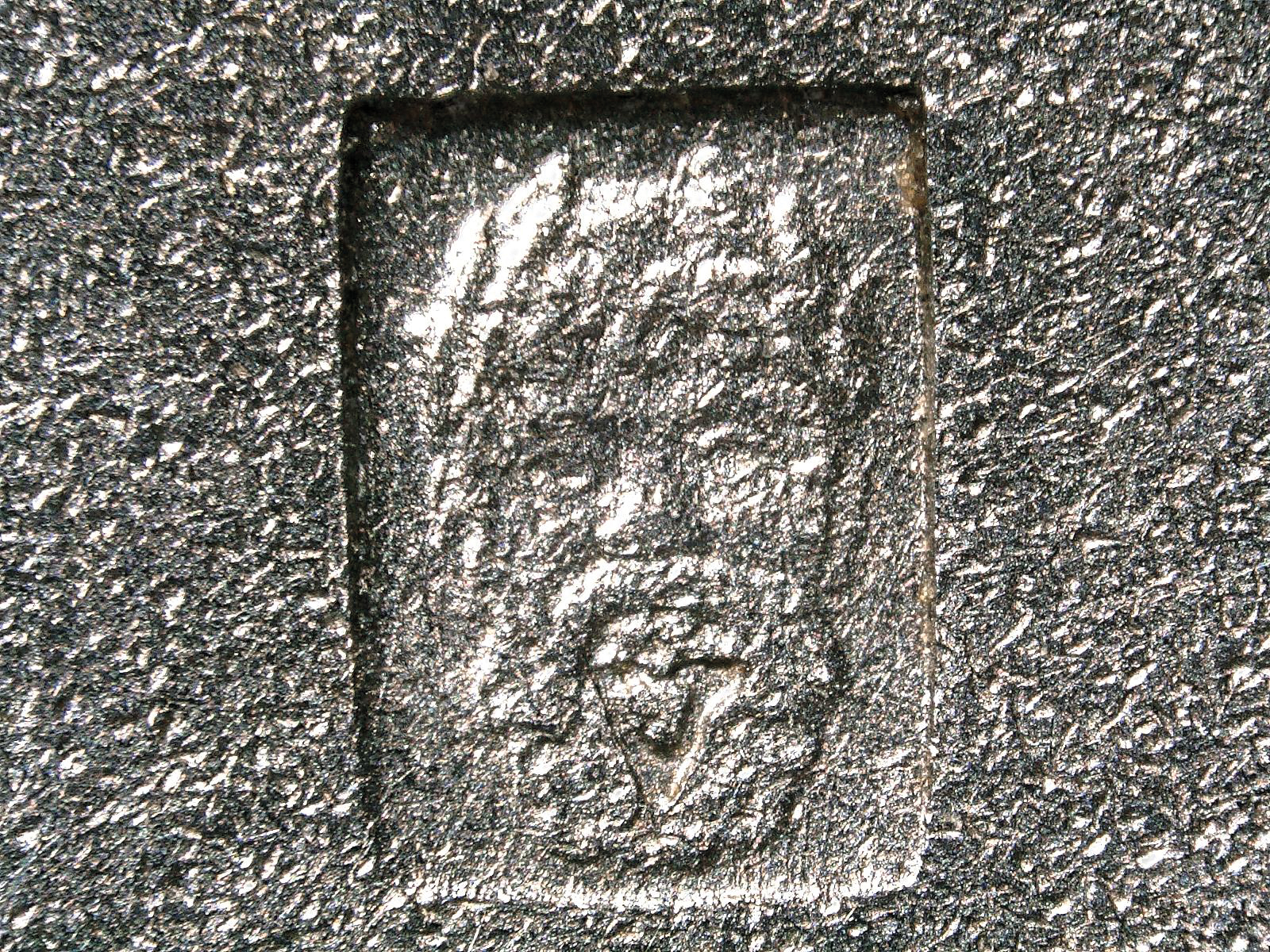
Mask hallmark (in the form of a Greek male head) stamped with a “V” Regional Assay Office symbol Extremely rare, throughout decades only two examples with the exact enamel Arabic “Roulette” configuration have surfaced. Both cased in platinum bearing consecutive Victorin Piguet 11’’’ ebauche movements. These movements were produced during the downfall of the global economy in 1929, the beginning of the Great Depression, and therefore were never cased. With the game-changing unveiling of the Ref. 96 as a novelty in 1932, the movement was further upgraded by the manufacturer and fitted into the modernist platinum case of the Ref. 96 with Bauhaus influences. Movement numbered 198’297 with an English calendar, is now part of Patek Phillipe Museum collection, and movement numbered 198’298 with a French calendar was sold in 1996 to a private collector. Previously unknown, the present platinum Ref. 96QL is one of three of such example ever known to the market, and lo and behold, the only one that has not only a provenance, but an imperial one. All three examples date back to 1937 with consecutive movement numbers within close case number proximity. The present example bears a movement numbered 198’299 and a case number 294’462, one number following the example sold in 1996 and is fitted also with a French calendar.
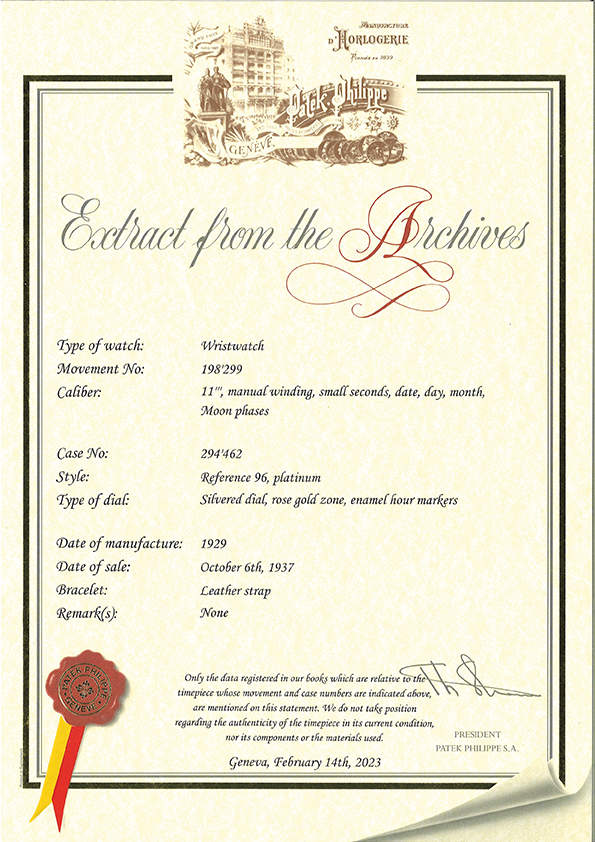
Kept in its original untouched condition, including the strap and buckle with consistent patina throughout, this time-capsule piece comes with incredible historical importance, and is an epitome of its kind. Further cementing its authenticity, the present lot is delivered with the Patek Philippe Extract from the Archives confirming the present timepiece was fitted with a silvered dial, rose gold ring and enamel hour markers. A movement manufactured from 1929, it was later sold on 6th October 1937. A once in a lifetime opportunity to obtain a timepiece that is worthy of a museum’s collection. For astute collectors, what is presented today is not only about collecting a significant part of Patek Philippe’s history, but world cultural history.
The Dial
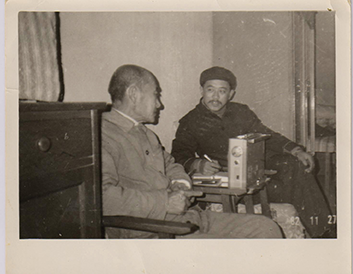
Wang Wenfeng (on right) interviewing Li GuoXiong "Big Li"(on left) in 1982. © Palace Museum of The Manchurian Regime A magnificent watch. Incredible provenance. Beautiful back story. But what is with that dial? Such were our thoughts at Phillips as the owner of Emperor Puyi’s watch revealed it to us.
The strange dial is the first thing one notices when examining this platinum-cased Patek Philippe Ref. 96QL timepiece. The watch, featuring a French calendar, has aged with a fascinating and bizarre patina. But what is most striking is its colour, half off-white, and half brass. Unlike the other two known examples of this model encircled by a pink gold roulette ring, Puyi's timepiece showcases a patina that perfectly aligned to the top edge of the calendar apertures, just above the hour markers of 3 and 9.
Why had somebody altered the watch dial? Was it meant to represent yin and yang—or day and night? We dug in and began investigating this puzzle. And three years on, we have solved the mystery—with the help of a former museum researcher and author who interviewed every close member of Puyi’s family and entourage.
In 1982 Puyi’s long-time servant, Li Guoxiong, discussed this in an interview with Wang. (Puyi repeatedly mentions ‘Big Li’ in his autobiography, From Emperor to Citizen.) In 1924 the 13-year-old Li started working in the imperial palace as Puyi’s servant, writes Wang, who interviewed Li more than 20 times in 1982. Li attended his master for 33 years, until 1957. A versatile craftsman, Li was Puyi’s trusted handyman. The multitalented attendant knew how to take photographs, develop film, and repair cameras. His knowledge of mechanics and machinery also enabled him to fix Puyi’s watches and glasses.
During their five years in the Soviet Union, Puyi had too much time on his hands and was often bored, Li told Wang. He would idle away the time by painting, practising calligraphy, and writing stories from folklore he had learnt. One day Puyi asked Li to open the watch and study its internal mechanisms. Wondering if the dial was made of platinum, Puyi instructed Li to remove the surface of the dial to examine the layers. After Li had meticulously removed the paint, Puyi noticed that the dial was brass, not platinum (unlike the casing). Puyi stopped his servant from further tampering with the watch.
The original state of the dial can be seen from an example published in Patek Phillipe Museum Collection II. Cased in platinum, an off-white sector dial features the signature “PATEK PHILIPPPE & CO GENÈVE” crafted with hard enamel. The technique begins with engraving the letters onto the dial plate before it is painted in black enamel. The dial is then fired to achieve its appearance. The date of the month and time of the day are painted on a satin-finished, rose-coloured ring with white divisions and black outlines. The date is marked with arrow-tipped blued steel hand with optimal legibility. Above the signature floats an inverted gold moon phase across a serene night blue sky. The passage of time is shown with a pair of pink gold Feuille hands harmonized with the accents on the dial.Thus, the watch bears permanent evidence of the emperor’s idle curiosity—and the trust he placed in his closest servant to investigate the precious timepiece.
Manufacturer:
Patek Philippe
Year:1937
Reference No:96QL
Movement No:198’299
Case No:294’462
Model Name:Calatrava
Material:Platinum
Calibre:Manual, 11’’’ Victorin Piguet ebauche, jewelled
Bracelet/Strap:Crocodile
Clasp/Buckle:Stainless steel pin buckle engraved AW
Dimensions:30mm diameter
Signed:Case, dial and movement signed
Accessories:Delivered with the Patek Philippe Extract from the Archives confirming its date of manufacture of the present timepiece in 1929 and its subsequent date of sale 6th October 1937.
Literature:The Patek Philippe Ref. 96QL with roulette dial is prominently illustrated in Patek Philippe Watches Volume II published by
Patek Philippe Museum, p. 282Literature
The Patek Philippe Ref. 96QL with roulette dial is prominently illustrated in Patek Philippe Watches Volume II published by
Patek Philippe Museum, p. 282Artist Biography
Patek Philippe
Swiss • 1839
Since its founding in 1839, this famous Geneva-based firm has been surprising its clientele with superbly crafted timepieces fitted with watchmaking's most prestigious complications. Traditional and conservative designs are found across Patek Philippe's watches made throughout their history — the utmost in understated elegance.
Well-known for the Graves Supercomplication — a highly complicated pocket watch that was the world’s most complicated watch for 50 years — this family-owned brand has earned a reputation of excellence around the world. Patek's complicated vintage watches hold the highest number of world records for results achieved at auction compared with any other brand. For collectors, key models include the reference 1518, the world's first serially produced perpetual calendar chronograph, and its successor, the reference 2499. Other famous models include perpetual calendars such as the ref. 1526, ref. 3448 and 3450, chronographs such as the reference 130, 530 and 1463, as well as reference 1436 and 1563 split seconds chronographs. Patek is also well-known for their classically styled, time-only "Calatrava" dress watches, and the "Nautilus," an iconic luxury sports watch first introduced in 1976 as the reference 3700 that is still in production today.
View More Works
Former property of the last Emperor of the Qing Dynasty, Aisin-Gioro Puyi PLEASE NOTE, THIS LOT IS A PREMIUM LOT. TO BID ON THE LOT YOU MUST COMPLETE AND SATISFY OUR PREMIUM LOT PRE-REGISTRATION PROCEDURE NO LATER THAN 24 HOURS BEFORE THE START OF THE AUCTION SESSION IN WHICH IT IS OFFERED. PLEASE ALSO NOTE THAT ALL BIDDERS MUST PLACE BIDS IN PERSON, VIA ABSENTEE BID, OR BY TELEPHONE. PLEASE CONTACT THE DEPARTMENT FOR DETAILS.
Σ✱3
Ref. 96QL
An exceedingly prestigious, historically important and previously unknown platinum triple date wristwatch with small seconds, moon phases, roulette-dial, enamel Arabic numerals, pink gold Feuille hands, former property of the last Emperor of the Qing Dynasty, Aisin-Gioro Puyi
1937
30mm diameter
Case, dial and movement signed
In excess of HKD25,000,000/USD3,000,000
Sold for HK$48,850,000
Thomas Perazzi
Head of Watches, Asia
+852 2318 2001
WatchesHK@phillips.com
The Imperial Patek Philippe Sale
Hong Kong Auction 23 May 2023

